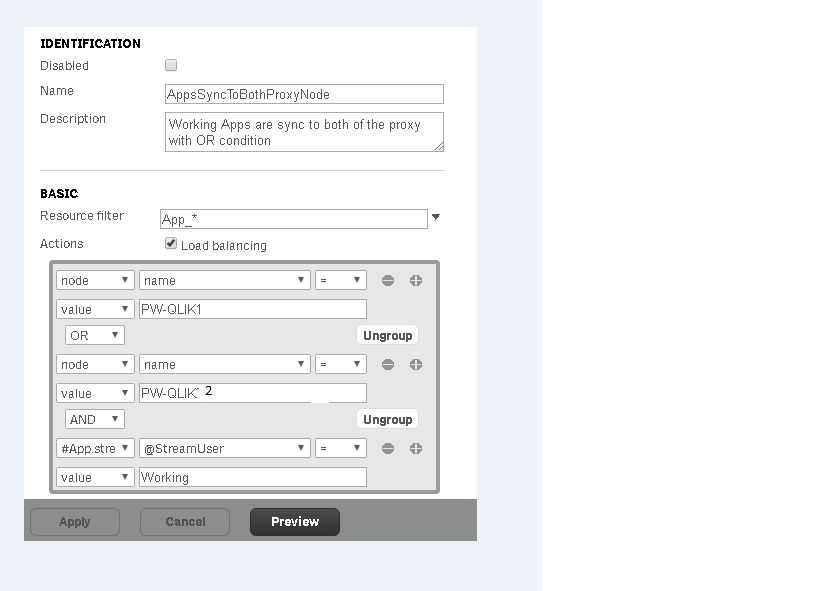Unlock a world of possibilities! Login now and discover the exclusive benefits awaiting you.
- Qlik Community
- :
- Forums
- :
- Analytics
- :
- Products & Topics
- :
- Integration, Extension & APIs
- :
- N Printing Connection with Shared Persistence
- Subscribe to RSS Feed
- Mark Topic as New
- Mark Topic as Read
- Float this Topic for Current User
- Bookmark
- Subscribe
- Mute
- Printer Friendly Page
- Mark as New
- Bookmark
- Subscribe
- Mute
- Subscribe to RSS Feed
- Permalink
- Report Inappropriate Content
N Printing Connection with Shared Persistence
Hi Techies,
I have configured shared persistence on Sep version and facing performance issue while connecting it to N printing.
I have one CENTRAL, Two Proxies Nodes(Proxy and Engine Services) and Two Scheduler Nodes.
I have created one security rule which SYNC apps to proxy nodes with custom property assigned to Stream which contains apps.

Case 1. When I am making connection in N printing with Central Node proxy and executes the N printing Task, It consumes resources of CENTRAL NODE rather than Proxy nodes.
Case 2. When I am making connection with any of proxy nodes using proxy of Porxy nodes, PERFORMANCE IS VERY BAD as compare two CASE1.
Central node configuration is same as proxy nodes.
My first question is:
1. Can anyone explain why Qlik is behaving like it, or I am missing something ?
2. If I SYNC any app to proxy app and open the same app on central node, which node resource it should utilize ?
Thanks in Advance!
- Tags:
- shared persistence
- « Previous Replies
-
- 1
- 2
- Next Replies »
- Mark as New
- Bookmark
- Subscribe
- Mute
- Subscribe to RSS Feed
- Permalink
- Report Inappropriate Content
Hi Toni,
Please find my comments for your latest inputs:
1. You have defined 5 ways to configure persistence layer, I believe all are there for store repository database and apps out of central node so if if my central node get down, my backup node will start fetching data from that external location(persistence layer).
2. Yes I have made connection with Proxy nodes but if I remove central node from virtual proxy of proxy nodes, data from Work Section will be disappear. If any user creates a new application it appears in WORK section so if I remove the central virtual proxy from the proxy nodes, these kind of apps will not appear.
3. Lets say I have made a connection with proxy node and I have two proxy nodes and one central node, both proxy nodes and central nodes have same RAM and CPU, I have noticed consumption of RAM and CPU of central node is more than proxy nodes though reports are generating on both proxy nodes and central node. My question is, do central node has priority than proxy node ?
Please add your inputs for above comments.
Your every input is valuable for me.
Thanks
Rohit
- Mark as New
- Bookmark
- Subscribe
- Mute
- Subscribe to RSS Feed
- Permalink
- Report Inappropriate Content
All Qlik Sense nodes in a shared persistence deployment access the persistence layer on equal terms. Each nodes retrieves information and files as needed. All changes to data is done directly to persistence layer, there is no copy of data in each node. The only function of the central node in this setup is to coordinate scheduler execution and administrative site tasks.
Node purpose is one way to affect 'Work' appearance. Review node purpose in your configuration: Editing a node ‒ Qlik Sense
Your front end proxy node should not load balance over the back-end node(s). The back-end node(s) should only execute app reloads. It is also possible that you have added too much complexity to your configuration, which leads to that you are not able to predict the user session execution. My recommendation on this part is still that you reach out to Qlik Support for more specific guidance based on your configuration, as I can not review your current settings.
- « Previous Replies
-
- 1
- 2
- Next Replies »